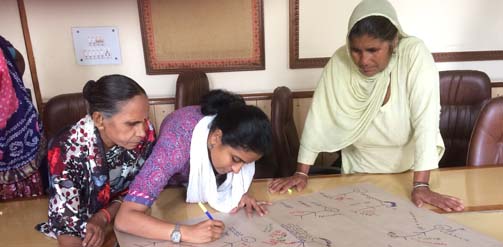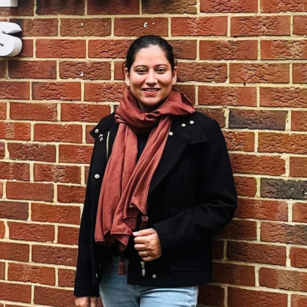Praxis and researchers from the IDS-led Participate Initiative have been working with representatives of India’s denotified tribes (DNTs) to challenge the discrimination that results in their everyday exclusion, for example when dealing with service providers such as doctors, teachers and the police. Jackie Shaw reflects on how power dynamics within diverse group processes can both contribute to and constrain the building of a collective platform to challenge such discrimination, in an ultimate goal to “leave no one behind”.

I have recently returned from India, where I accompanied Participate partner Praxis during participatory research and communication activities with eight denotified and nomadic tribes (DNTs). These are highly stigmatised communities, branded ‘criminal’ by the 1871 Criminal Tribes Act. Although repealed in 1952, the effects of this Act were perpetuated in many Indian States by the Habitual Offenders Act that replaced it. This means approximately 150 million people from DNTs are ‘born-criminal’.
My visit was part of the British Academy funded Building Sustainable Inclusion research, the latest phase of the Participate Initiative. This current programme is exploring how intersecting inequalities drive poverty, as well as pathways to more accountable governance relationships. This knowledge is central to achieving the Sustainable Development Goals (SDGs), and Praxis is working with DNT communities because they have been left behind – to an extreme extent – by global policy.
My experiences whilst there got me thinking about the differences between bringing people from mixed backgrounds together to build shared understanding and common purpose, and working with more homogenous groups. Praxis ran both a two-day Ground Level Panel (GLP) and a one day stakeholder engagement event. Both events were an initial step in engaging people from the margins, and together they caused me to reflect more deeply on the value of different group processes at different stages, and the tensions and trade-offs associated with them.
How can we bring diverse groups together to build a strong platform that engages those in power?
The Ground Level Panel brought together 11 individuals, who represented eight DNTs from five States. DNTs face difficulties influencing governance in part as they do not identify collectively due to their diverse tribal backgrounds. For example, the DNTs present included forest dwellers who live off the land, alcohol producers, street artists and performers, traditional sex workers and fishing communities.
Rather than opening up the differences between them, which might have divided the group, the GLP process began by exploring participants’ everyday experiences dealing with service providers such as doctors, teachers and the police. Finding commonalities in the discrimination they faced provided the basis for group bonding. They then went on to discuss shared issues, and the results of the community-based research that had been undertaken.
On the second day they reflected on their SDG priorities, and the gaps in current government policy and provision. This resulted in four policy recommendations:
- Freedom from criminality, suspicion and stigma
- The right to institutional protection and participation
- The enumeration and disaggregation of data for DNTs
- The right to budgetary provision
On the final day, the GLP, an expert panel and a range of influential state and civic actors were brought together to further deliberate the research findings and recommendations. My role was to support Praxis in documenting some of the issues and recommendations on video, to show alongside participants digital stories at the event and in other global forums.
The GLP participatory research was linked to a national campaign to raise awareness about the plight of DNTs. This is part of Praxis’ strategy to build accountable governance relations. There is no doubt for me that this, combined with building collective leverage through focusing on commonalities, was a key strength in this approach.
Can participatory processes address power imbalances in diverse groups?
Power imbalances will be present within any group. Although participatory processes are meant to open inclusive forums, if a group is too diverse it is hard to avoid the most influential people dominating at the expense of the least, especially when time is short. In this mixed gender group, there were a range of ages, three languages, and different prior communication experience, in addition to the various backgrounds.
Despite the facilitators working to create space for all, it is clear that the nuanced differences between people’s experiences could be submerged or missed. This aspect is important to our research because it exemplifies the intersecting aspects of identity that we need to understand as barriers to accountability.
A common strategy for engaging the least influential people in inequitable contexts, is to work with more homogenous groups in a ‘safe space’ as a first process stage. This creates the possibility of building communication capacities and awareness before they enter wider public dialogue, so that the initially unconfident can exert the same leverage as others.
I am not suggesting that either a mixed background group, or a homogenous group, is best. What works depends on the specific context and the purpose of the process at that stage.
Building collective identities whilst not forgetting how power dynamics can constrain individuals
In this case there was clear value in bringing the diverse tribes together to build a strong enough platform to get those with power to respond to the issues. However, it did highlight the importance of thinking about how to navigate between building shared purpose, and understanding the diversity of experiences that result from the multiple inequalities people face. Ignoring this dynamic raises the danger of increasing influence for some whilst exacerbating marginalistion for others, which is a common block to positive change for those most ‘left-behind’.
How those involved navigate and address these real-world challenges is part of our research learning. The key challenge we are grappling with is how to understand the intersecting identities that drive inequity, without bringing out painful differences between people. In particular we know that building collective identities is important to leveraging influence; however, it must be recognised that, as in any other research and advocacy process, the usual power dynamics that serve to constrain people are at play.
Photo credit: Jackie Shaw, 2017.
